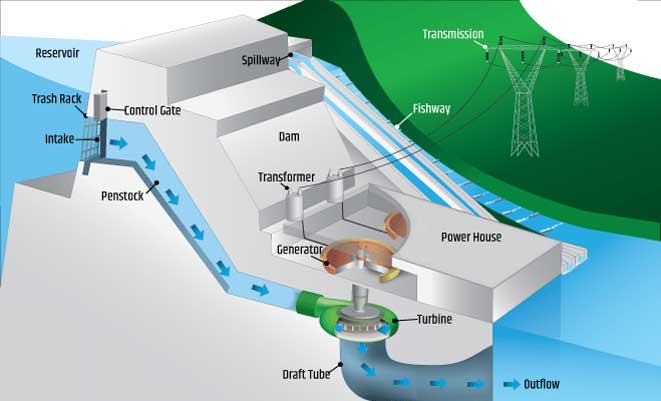
Hydropower for Construction Dams: A Proper Guide in Penstock

Hydroelectric power is a renewable source of energy that can be used for both domestic & mechanical purposes. The production of hydroelectric power occurs as the moving water spins a turbine that then activates a generator to produce electricity.
As the demand for renewable energy increases, modern nondestructive testing technologies can be used to ensure these critical structures are intact and operating efficiently.
Define Penstock
Penstocks are hydraulic structures that transmit fast streams of water under pressure from fore-bays or headrace tunnels to the power houses in order to run turbines and generate power.
Most commonly, it is used for surface water drainage and foul water sewage systems. While providing water to waste management facilities and power plants, it isolates discharges and controls the flow of water.
Penstock Workflow
An important component of a hydropower system is the penstock. Water is carried from the source to the turbine in the power station by penstocks, which are pressure vessels in the form of channels or pipes.
Their length, circumference, and number vary depending on the size of the facility. There are two sizes of penstocks at Hoover Dam. There are sixteen 13-foot diameter penstocks totaling 5,800 feet & one set is 30 feet in diameter.
In hydro turbines and sewerage systems, a penstock is a sluice or gate or intake structure that regulates water flow. Mill ponds and watermills influenced the term.
At mill sites, they are often used to maintain water flow through the mill wheel, or to dispense water into mill pools.
Hydroelectric Dams & Systems
A surge tank and a gate system are typically provided with hydroelectric penstocks. Depending on the application, they may include anchor blocks; drain valves, air bleed valves, and support piers.
1. Turbine operation controls flow, which is zero when turbines are not operating. The device is especially efficient in polluted water systems, and it requires hot water washing, manual cleaning, anti fouling coatings, and desiccation for proper performance.
2. Channels leading to and from high pressure sluice gates are also referred to as channels in irrigation dams.
3. Mine tailings dams are also constructed with them. Penstock rings are used to build up the penstock, which is located fairly close to the center of the tailings dam.
4. They allow the slimes to settle out of the water by maintaining the water level. Through a penstock pipeline, this water is piped back to the plant beneath the tailings dam.
Landfills
Several landfill sites have surface water management systems that include penstocks. In attenuation lagoons, storm-water is held, limiting discharge to predevelopment levels.
If the surface water becomes contaminated, the penstock can be sealed at the outfall from the lagoon. As a result, contamination of the environment will be controlled since the site will be isolated from the watercourse.
Anchor Block
The penstock carries water at tremendous pressure, exerting thrust at critical points, e.g. junctions, bends, etc. If this thrust is not supported or anchored, it may cause damage and the penstock can be blown upward. Anchor blocks are provided at various intervals along the penstock to prevent this thrust.
Penstock Applications
1. Among the uses for penstocks are sewerage systems, community water supply systems, irrigation systems, hydropower systems, etc. The application here will be limited to the hydropower sector.
2. Depending on site conditions and project requirements, hydroelectric headrace tunnels can be used as penstocks. In general, penstocks are made from mild steel due to its better corrosion resistance and minimal frictional losses.
To learn more, watch the following video tutorial.
Video Source: saVRee
3. At hydraulic turbines, a control valve is also provided to control penstock supply in case of repairs & maintenance in turbines.
4. It is recommended to dig some excavations and take penstock through them to prevent corrosion and other surface issues, such as animals. The topography and site constraints will determine how the penstock is surfaced or buried.


